We warmly welcome Graham Phillips, author of The Mystery of Doggerland, as our featured author for August. Graham Philips investigates the latest marine archaeological evidence and scientific analysis of Doggerland, a sizeable underwater land mass that once connected Britain to continental Europe. Before rising sea levels submerged it, Doggerland hosted an advanced civilization that emerged at least as early as 4000 BC. Philips’ book explores the remnants of this sophisticated civilization — artificial structures, complex settlements, gigantic earthworks, epic monoliths, and huge stone circles— detected beneath the ground and on the ocean floor through remote sensing and seismic profiling. In his article here, Phillps introduces some of the mysteries surrounding this enigmatic megalithic culture that vanished beneath the North Sea 5000 years ago.
Interact with Graham Phillips on our AoM Forum here.
In one way or another, the coronavirus pandemic adversely affected nearly everyone on Earth, shattering lives, devastating the world economy, causing untold suffering, and killing millions. Covid-19 was frightening enough, but there is a far more perilous and long-term threat to human life – climate change. If unchecked, global warming will almost certainly result in the submergence of some of the world’s largest metropolitan conurbations; entire nations will be pounded by overwhelming mega-hurricanes and gargantuan tornados, and their coasts thrashed by giant tsunamis caused by collapsing ice sheets; vast wildfires will rage out of control, consuming farmland, forests, and cities; an intolerable number of animal and plant species will go extinct, and famine on a worldwide scale could decimate humanity. Furthermore, deadly viruses, far worse than Covid-19, may be released from melting ice, and diseases against which we have no resistance might all but exterminate our species. How do we know? Not only through scientific projections but because it has all happened before, during a terrifying era when the planet critically warmed after the last ice age, and terrible catastrophes devastated cultures that existed millennia before the rise of ancient Egypt.
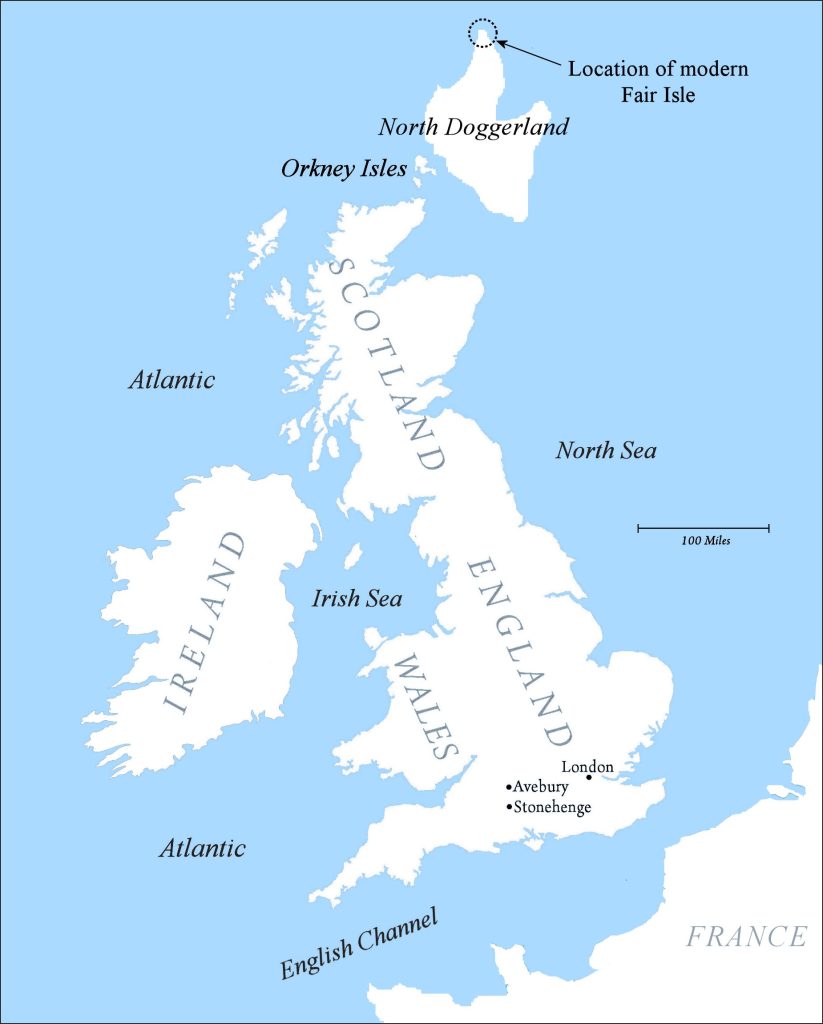
The British Isles and northwest Europe, showing the location of prehistoric North Doggerland as it existed around 8000 years ago.
When the ice age ended around 10,000 BCE, temperatures gradually rose until approximately 7000 BCE, after which they remained relatively stable for 2000 years. During this period, early cultures became established as proto-civilizations that mastered brick-building techniques, erected stone and earthen monuments, crafted pottery, smelted soft metals such as gold, silver, and copper, and lived in large settlements of over 1000 people. The remains of many of these proto-civilizations have been discovered throughout the world, such as at Plovdiv in Bulgaria, Erbil Citadel in Iraq, Jiahu in China, Huaca Prieta in Peru, Monte Verde in Chile, Yarim Tepe in Iran, Çatalhöyük in Turkey, and Jericho in Palestine.1 They flourished for centuries until around 5000 BCE when temperatures again began to rise – as did sea levels – for a further 1000 years. Inland cultures were devastated by extreme heat, drought, and plague but survived the rising waters, whereas other coastal settlements were destroyed by tsunamis or wholly submerged. These included the inhabitants of Majuán Island, now Majuán Bank, off the northwestern coast of Morocco,2 the Mokaya people of Soconusco in southwest Mexico,3 the Mehrgarh people of what is now the Indus Shelf off the coast of Pakistan,4 the Peiligang culture in the Yi-Luo basin in China,5 and the inhabitants of the Gulf Oasis on the northwest coast of the Persian Gulf.6 In this article, we focus on one such early civilization that until recently remained utterly unknown. A lost civilization that seems to have founded the Megalithic culture of the British Isles, the builders of Stonehenge. Evidence of the ancient cataclysm to befall these people has been dramatically discovered off the northernmost coast of the British Isles – an ancient stone circle, earthworks, an artificial mound, and fallen monoliths found underwater, on the floor of the North Sea.
Around 3000 BCE, the inhabitants of Great Britain and Ireland transformed rapidly into the Megalithic culture that erected hundreds of stone circles unique to the British Isles. Across these islands, monumental complexes were created, consisting of huge stone circles surrounded by ringed ditches, and accompanied by massive artificial mounds, stone avenues, and free-standing monoliths. Such complexes were scattered throughout the countryside with smaller stone circles in between, often linked by alignments of individual monoliths covering many miles. Yet there are no written records from this era, writing not coming to the British Isles until the Roman invasion in the first century CE. As with so much concerning the Megalithic culture, its origins are shrouded in mystery.

The Stones of Stenness on the Orkney Islands, the oldest Megalithic stone circle still surviving on dry land. (Photography by Deborah Cartwright)
It was once thought that the Megalithic culture (from an ancient Greek term for “large stones,” referring to their monuments) began in the south of England, where Stonehenge is situated, before moving north, perhaps originating with migrants from northern France, where there are many ancient standing stones. However, there is no evidence of stone circles or their accompanying monuments like those in the British Isles in France or elsewhere in continental Europe. Since the advent of scientific dating techniques, it is now known that the oldest Megalithic stone circles are those in the northern British Isles, implying that the practice began there and then moved south. The revised conjecture was that it began around five millennia ago on the Orkney Islands off the north coast of Scotland, where the oldest datable stone circle was found. Yet, despite this, it seems highly unlikely that the Megalithic culture originated even there. Surprisingly advanced for the time, it appeared on the Orkney Islands abruptly – virtually overnight in archeological terms – with a complex societal structure, mastery of building techniques, sophisticated ceramics, and astonishing knowledge of herbal medicine already established, implying that it must have started and developed elsewhere. However, modern experts have long been baffled about where this might have happened. Nowhere in mainland Europe or Scandinavia was there anything remotely similar. So where did the Megalithic culture originate?
Stonehenge is the Megalithic culture’s most famous creation. Yet the monument we see today, constructed around 2500 BCE, is far from the oldest stone circle in the British Isles. That is the Stones of Stenness, some 700 miles to the north. The Stenness stone circle stands in isolated, windswept heathland on an island called Mainland, the largest of the Orkney Islands, some 10 miles off the northern tip of Scotland. It now consists of four stones, up to 15 feet high, standing in a semicircle, with three smaller monoliths lying flat inside the arrangement. As with many stone circles, over the years, stones have been toppled and broken up for building materials or smashed apart by vandals. From the radiocarbon dating of organic material found beneath the stones still standing, the circle seems to have been erected around 3100 BCE and, from tell-tale signs in the soil, it appears to have once consisted of 12 monoliths, equally spaced in a circle of just over 100 feet in diameter.7 Mainland Isle additionally boasts one of the largest stone circles in the British Isles. The Ring of Brodgar is some 340 feet in diameter, originally consisting of 60 stones, of which 27 remain, standing up to 15 feet high. It was surrounded by a 400-foot-diameter circular ditch about 10 feet deep and 30 feet wide with an outer embankment, much of which has eroded due to its setting, exposed to the relentless North Atlantic weather. Some 450 feet southwest of the stone circle is an artificial hillock called Salt Knowe, a 130-foot-wide, 20-foot-high mound thought to have been built simultaneously between 2500 and 3000 BCE.
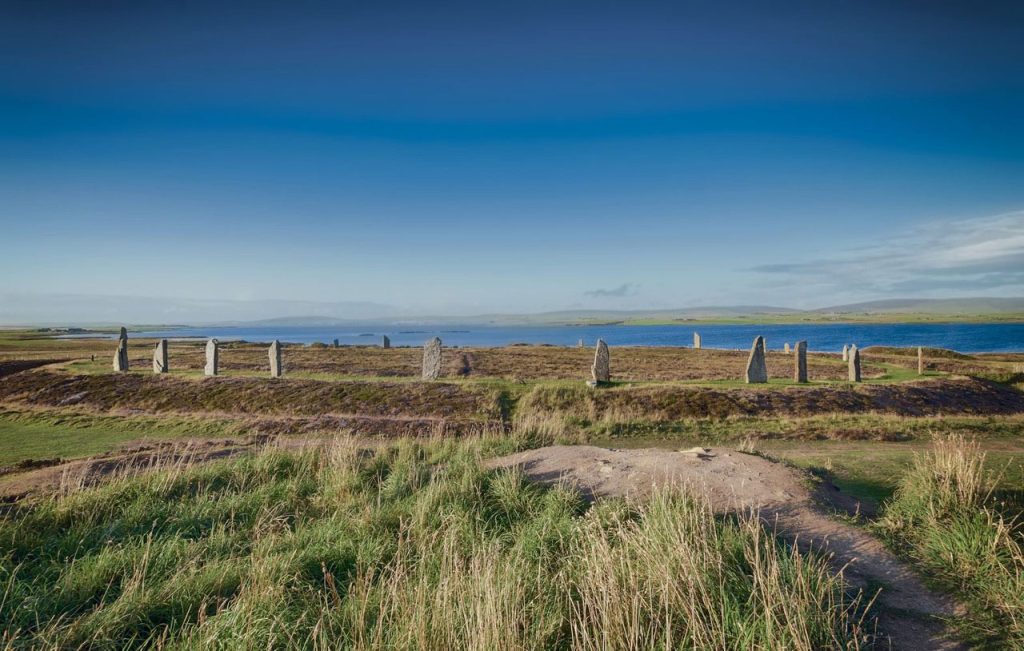
The Ring of Brodgar on the Orkney Islands is over 4500 years old. A similar stone circle, dating from over 1000 years earlier, has now been discovered at the bottom of the North Sea. (Photography by Deborah Cartwright)
In 2011, in the Bay of Firth off the eastern coast of Mainland Isle, around a third of a mile offshore and 12 feet beneath the waves, scientists conducting an underwater survey using radar and sonar discovered a submerged circular embankment with an inner ditch around 450 feet in diameter – clearly an artificial construction. On closer examination, within the ring, there seemed to be the remains of a stone circle: six fallen monoliths around 15 feet long lying on the seabed, their regular shape revealing them also to be artificial creations. When their positions in relation to one another were considered, they appeared to have been the remains of a stone circle around 350 feet in diameter which may have originally consisted of some 50 to 60 monoliths. Additionally, around 450 feet southwest of the circle, there appeared to be the remains of an artificial hillock, 130 feet in diameter and some 10 feet high. All this suggested they had discovered a monument very similar to the Ring of Brodgar. The stones’ size, number, height, surrounding ditch and embankment, diameter, and nearby artificial hillock were almost identical.8
This was indeed a fascinating discovery, but it seemed nothing unique besides the fact that it was underwater. The remains of many Brodgar-like, large stone circles exist throughout the British Isles, such as at Avebury, 17 miles north of Stonehenge. These huge stone circles, with their surrounding earthworks, are referred to as Megalithic complexes, of which there were dozens created throughout the British Isles. As these complexes date from the most active period of stone circle building, between 3000 and 2500 BCE, archaeologists assumed that the sunken circle dated from that time and was submerged when water levels rose. But all that changed in 2019 when marine archaeologists finally sent divers to examine the site. (It had taken some years to get financial backing for the project.) Everyone was astonished when dating revealed the monument to be at least 6,000 years old.9 This date of approximately 4000 BCE, perhaps earlier, made it at least 1000 years older than the Stones of Stenness, the earliest known stone circle. To put this into context, this was 1000 years before the first kings of Egypt and one and a half millennia older than the assumed date of the Pyramids of Giza. And the sunken complex was as sophisticated as the Megalithic complexes throughout the rest of the British Isles, not built until after 3000 BCE.
There could be no doubt that well before stone circles were erected anywhere else in the British Isles, an advanced Megalithic complex was created on dry land that once existed to the east of the Orkney Islands, on what is now a submerged bank, once an island known as North Doggerland. So, did the Megalithic culture originate in some long-ago sunken realm north of Scotland? The monumental complex on the seabed of the Bay of Firth is just one piece in an extraordinary jigsaw puzzle of historical and archeological clues revealing that a sophisticated civilization hundreds of years older than the Sumerians, the Ancient Egyptians, or the Harappan civilization of India, once existed on what had been a land to the northeast of the Orkney Islands – an ancient culture with prehistoric technology years beyond its time.
But how might such a civilization have sunk beneath the waves? The last ice age began around 110,000 years ago, reaching its peak about 20,000 BCE when the average world temperature was some 5 degrees Celsius (10 degrees Fahrenheit) lower than today. That enabled the polar ice caps to grow astonishingly, making large parts of the Earth uninhabitable. With so much water tied up in ice, there was less rainfall worldwide, and prolonged droughts spelled disaster for plants, animals, and humans. Over half a mile thick, the northern polar ice cap spread south beyond The Great Lakes in North America and to southern Britain in Europe. By then, so much of the world’s water was held in ice that global sea levels were an astonishing 400 feet lower than today. Scientists can determine prehistoric sea levels by examining the remains of coastal marine vegetation and fossilized coral worldwide. Fauna and flora that live in shallow waters will die as sea levels rise, so finding their remains in strata of underwater silt enables dating. Around 20,000 years ago, temperatures began to rise, possibly caused by a slight shift in the Earth’s orbit around the sun. The ice melted, and the glaciers and vast ice sheets began to retreat, and by 14,000 years ago, sea levels had risen by approximately 140 feet.
By 10,000 BCE, the emergence of new land previously under ice had led to significant migrations of human populations and the beginning of small farming and village settlements – the so-called Early Neolithic era of our existence, as opposed to the previous hunter-gatherer way of life. By then, however, due to continually melting ice, global sea levels had risen by about 200 feet, and over the following three millennia, the waters kept rising until around 7000 BCE. This brings us to an era of human history known as the Late Neolithic when advances in crop cultivation and animal domestication led to larger settlements. In many parts of the world, humanity had entered an age of ceramics and sophisticated brick-making, the smelting of soft metals, and the first settlements of more than 1000 inhabitants had been established: the proto-civilizations mentioned earlier.10 Around 5000 BCE, the so-called Late Neolithic age began, when cultures stagnated or disappeared as temperatures and sea levels rose again and the climate-related disasters referenced above started to occur.
Before around 10,000 years ago, a large area of dry land known as Doggerland existed to the east of Great Britain, but as sea levels engulfed its central plane, it was divided into two islands referred to as North and South Doggerland. By 7000 BCE and the start of the Late Neolithic, only North Doggerland, an island that extended some 50 miles north and 40 miles east of the present-day Orkney Islands, remained. Because of the vast weight of the enormous ice sheet that had covered the northern British Isles during the ice age, the land beneath was compacted by hundreds of feet, and once the ice retreated, it took millennia for the land to rise to its pre-ice-age level. This is known as isometric adjustment, and because of it, North Doggerland remained above sea level much longer than the rest of Doggerland until around 5000 BCE.11 After this time, regional land rise slowed. Still, the waters continued to rise, and the sea gradually began to envelop North Doggerland until 4000 BCE, when all except the highest land was submerged. Over the following millennia, the sea level rose more slowly, and since around 3000 BCE, it has only risen by around 12 feet. This brings us back to the Megalithic complex in the Bay of Firth. We know it was built around 4000 BCE, but as it lies around 12 feet below the present sea level, it must have been on high land that did not fully submerge until about 3000 BCE – precisely when the Megalithic age began on the adjacent Orkney Islands.
So, the Bay of Firth discovery and the abrupt appearance of the surprisingly advanced Megalithic culture on the Orkney Islands, with no evidence of its development anywhere else in Europe, strongly implies that there was a precursor civilization on North Doggerland whose inhabitants were impelled to migrate to what is now the British Isles as rising sea levels gradually destroyed their homeland. North Doggerland is now a bank of land beneath the North Sea known as the Orkney Shelf, and it is hoped that future archeological surveys will reveal more spectacular finds. However, one last vestige of North Doggerland – indeed, of all Doggerland – does survive above sea level: tiny Fair Isle, a remote, treeless island, some three miles long and two and a half miles wide, around 45 miles north of the Orkneys. Over 7000 years ago, it had been an area of high moorland at the extreme north of Doggerland.12 As the only part of the land from which the Megalithic civilization might have originated to survive, is there any evidence of civilization or sophisticated early culture on Fair Isle predating the Megalithic period of the British Isles?
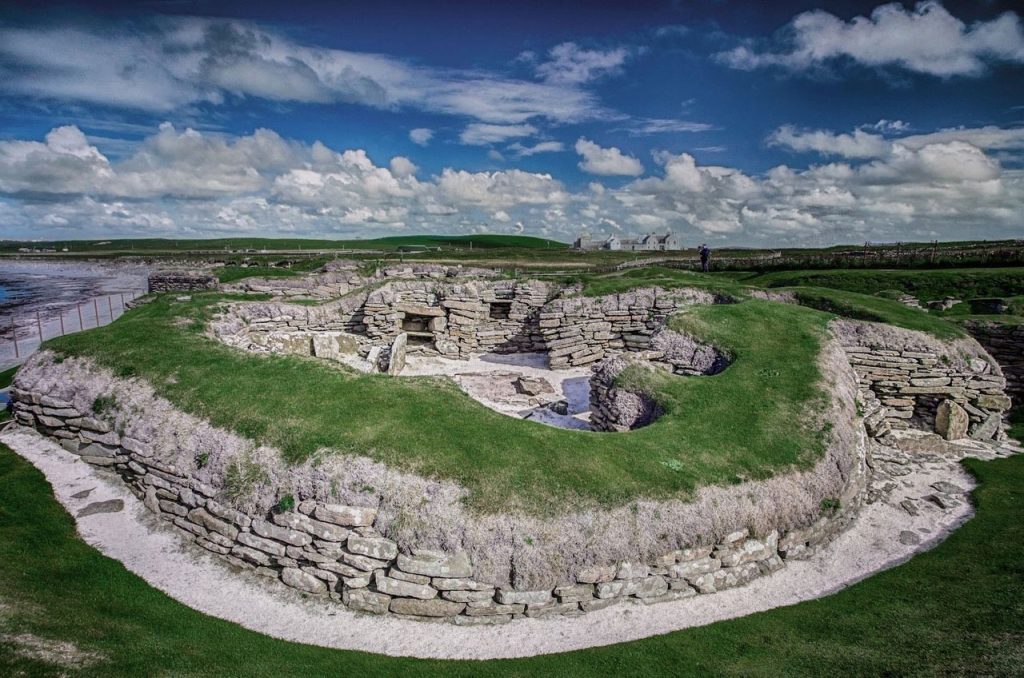
Dating from around 3100 BC, the settlement of Skara Brae, on the Orkney Islands to the north of Scotland, may have been established by the people of Doggerland after their homeland was destroyed. A similar village, dating from 500 years earlier, has been found on Fair Isle, the only part of Doggerland to survive above water. (Photography by Deborah Cartwright)
Between 1996 and 1997, excavations conducted by a team of archaeologists from Birmingham University at South Haven on the eastern side of the island uncovered the foundations of multiple buildings very similar to those found on the Orkney Islands at Skara Brae, a sophisticated Late Neolithic village with a stone drainage and plumbing system, consisting of interconnected subterranean dwellings, previously considered the oldest such settlement in the British Isles. The Skara Brae settlement dates to around 3000 BCE – but the South Haven settlement was established over 500 years earlier. And it was much more advanced. Here, pottery was found to be more sophisticated and needed much higher temperatures to fire than any ceramics found elsewhere in Europe. When subjected to scientific analysis, such ceramic vessels were found to have once contained substances extracted from plants likely to have been used for pharmaceutical purposes, such as salicylic acid from the buds of the meadowsweet herb, an analgesic, which in the nineteenth century was used to produce the first aspirin; amentoflavone obtained from juniper plants, known for its disinfectant properties and widely used as an ingredient in modern antiseptic creams; and seeds of the thorn apple, a deadly poison, but in the correct dosage, the only effective anesthetic known in Europe until the synthesis of ether in the nineteenth century. In addition, there were smaller buildings thought to have been used as saunas, 2000 years before the first sauna was known to have been invented in Finland.13 So, the last vestiges of what had once been a civilization on Doggerland expired by 3000 BCE, precisely when the Megalithic culture first appeared on the Orkney Islands before expanding throughout the rest of the British Isles. Some inhabitants of Doggerland might even have begun to leave their island in the early fifth century BCE. A sophisticated stone burial chamber called the Dwarfie Stane, excavated from solid rock and unlike anything found elsewhere in the British Isles, survives on the Orkney Island of Hoy. As it dates from 1000 years before the start of the Megalithic culture in Great Britain and Ireland, it may have been the tomb of an early migrant or migrants from the lost civilization of Doggerland.
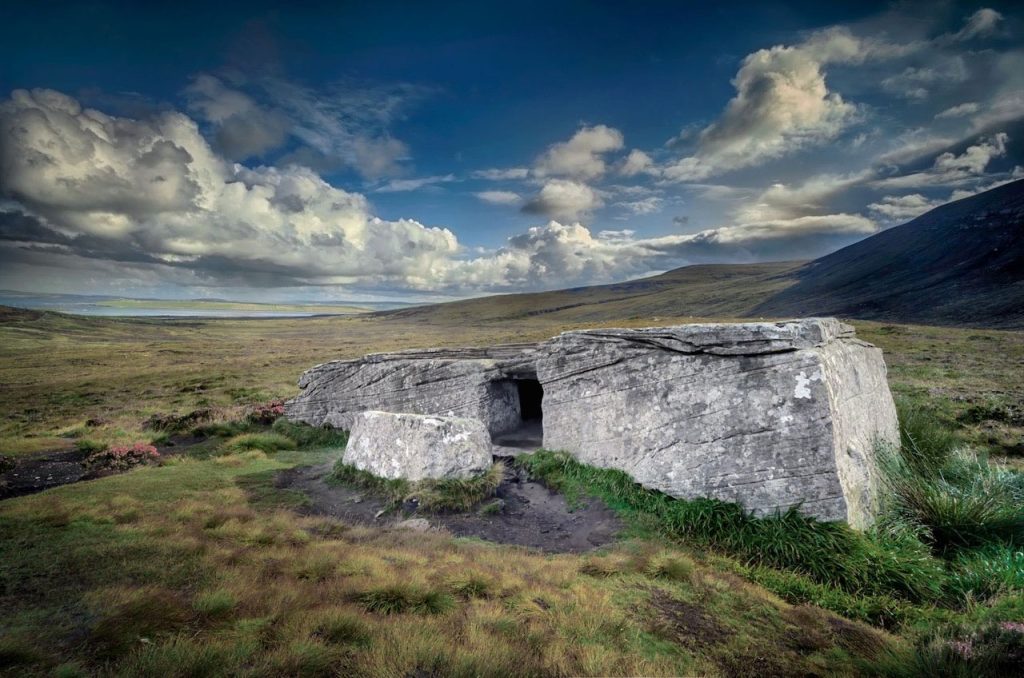
The Dwarfie Stane on Hoy Island of the Orkneys. This carved-out chambered tomb, around 6000 years old, may have been the burial place of settlers from Doggerland well before the Megalithic culture began on the British Isles. (Photography by Deborah Cartwright)
Remarkably, a lost civilization that once existed in the North Sea, which gave rise to the ancient stone-circle-building culture, was remembered in the mythology of the later Celts. Centuries after the first Megalithic monuments were erected in the British Isles, legends persisted concerning a sunken, once prosperous land that once thrived to the north of Scotland. The oldest written records concerning Britain were made by Greek explorers at the time of Alexander the Great, around 325 BCE. The native Britons of the time, the Iron Age Celts (who first arrived from mainland Europe around 700 BCE), told them of a lost realm that once existed to the north of their country: a sunken island they called Tu-lay. It was said to have been an island paradise that sank beneath the waves when the inhabitants angered their sea god. From here, the Celts maintained the stone circles builders originated. Indeed, legends of a sunken land to the north of Britain still survived to be recorded by foreign visitors to the British Isles many centuries later, particularly in Ireland, where much ancient mythology was recorded by Christian missionaries who first arrived during the fifth century CE. According to a collection of ancient Irish myths and legends, brought together into one volume during the Middle Ages known as The Book of Invasions, long ago, certain chosen people on a remote northern island were warned by the gods of a coming flood and sailed away to avoid the catastrophe, which included many people dying of plague. Incredibly, the discovery by marine archaeologists of the sunken megalithic monument in the North Sea and the finds on Fair Isle appear to be evidence that this lost land of Celtic mythology was more than mere legend.
So, how did this lost civilization end? Before it was flooded entirely, there were dreadful climatic changes. The remains of ancient vegetation excavated from the soil of Fair Isle suggest that there were prolonged periods of drought and deadly wildfires; irregular sandbanks deposited on the west of the island during the fifth century BCE imply that there had been repeated extreme storms and hurricanes; and, if the Celtic legends are any indication, there was ultimately a lethal epidemic. There even seems to have been a mega-tsunami that hit the island from the northeast around 4500 BCE, indicated by the remains of sea creatures deposited in the soil over 100 feet up hillsides and carbon-dated to around 4000 BCE.15 The event is thought to have been caused by the collapse of a vast glacier, induced by global warming, on the Norwegian archipelago of Svalbard. And here’s the frightening part. The rise in temperature at the time when all this was happening was less than two degrees Celsius. Today, the average global temperature has increased by just over one degree since 1880 – and two-thirds of that has occurred since 1975. It may not be long before we, too, face such an apocalypse. Indeed, in many parts of the world, it has already begun.
Bibliography
1. Maisels, Charles. Early Civilizations of the Old World: The Formative Histories of Egypt, The Levant, Mesopotamia, India, and China. Abingdon, UK: Routledge, 2003
2. Stanley, D. J. Geological Evolution of the Mediterranean Basin. New York, NY: Springer, 1985.
3. Voorhies, Barbara and Kennett, Douglas. Buried Sites on the Soconusco Coastal Plain, Chiapas, Mexico. Journal of Field Archaeology, Vol. 22, No. 1. Abingdon, UK: Taylor & Francis, 1995.
4. Kenoyer, Jonathan. Ancient Cities of the Indus Valley Civilization. Oxford, UK: Oxford University Press, 1998.
5. Guo, Jia. Wen, Wu Ju. China’s Major Archaeological Discovery. Norwalk, CT: Heritage Press 2014.
6. Rose, Jeffrey. New Light on Human Prehistory in the Arabo-Persian Gulf Oasis. Current Anthropology, Vol. 51. Chicago, IL: University of Chicago Press, 2010.
7. Ritchie, Graham. The Stones of Stenness, Orkney. Edinburgh, UK: NMS Enterprises, 1997.
8. The Scotsman. 19 October 2011. Stone circle to rival Ring of Brodgar found off Orkney coast.
9. The Express. 8 November 2019. Archaeology breakthrough: How ‘genesis of Stonehenge’ was found after Scottish Bay scan.
10. Mithen, Steven. After the Ice: A Global Human History, 20,000 – 5000 BC. London, UK: Weidenfeld & Nicolson, 2004.
11. Gaffney, Vincent; Thomson, Kenneth; Finch, Simon. Eds. Mapping Doggerland: The Mesolithic Landscapes of the Southern North Sea. Oxford, UK: Archaeopress, 2007.
12. Gaffney, Vincent; Thomson Kenneth; Finch, Simon. eds. Mapping Doggerland: The Mesolithic Landscapes of the Southern North Sea. Oxford, UK: Archaeopress, 2007.
13. Hunter, J. R. Fair Isle: Archaeology of an Island Community. Edinburgh, UK: Mercat Press, 1996.
14. Macalister, Robert Alexander Stewart. Lebor gabála Érenn: The Book of the Taking of Ireland. Charleston, SC: Nabu Press, 2010.
15. Hunter, J. R. Ed. Fair Isle survey: interim 1987, Bradford University, School of Archaeological Sciences, and Physics Occasional Papers, No.8. Bradford, UK: Bradford University Press, 1987.






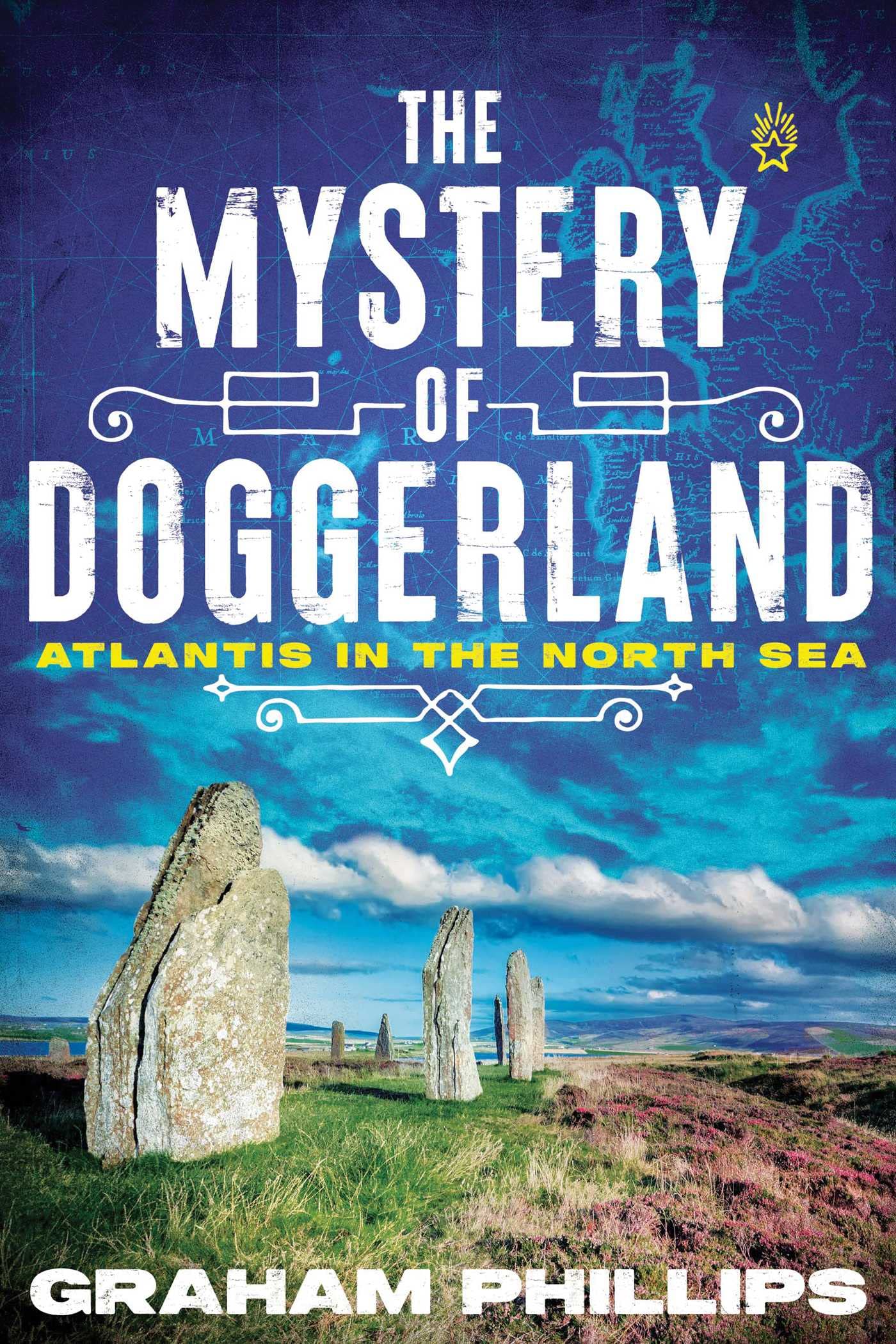

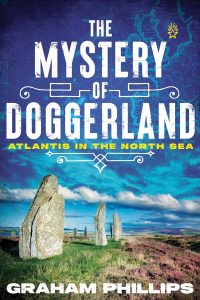
Doggerland makes things like the Oera Linda book interesting again. Even if it is simply a romantic reverie (“hoax” seems inaccurate, even if it is not literally as presented), it still draws on an echo of this actual, real, place and its tale, as a folk memory.
And the Dwarfie stane is reminiscent of these caves in India, albeit less precise. https://www.youtube.com/watch?v=-HdwjjHQBQM
Submarine exploration must surely have encountered objects and places of interest, but military institutions aren’t big on the humanities, sadly.
“ climate change. If unchecked, global warming will almost certainly result…” are you INSANE ??!!
So there goes your credibility…
Not to late for you to accept Jesus Christ as your Lord and Savior Graham , it’s ever so I buy you don’t know Him.
The Almendres Cromlech at Evora in Portugal was made 2000 years earlier, around 5000BC. Does this not count as older because it is oval shaped rather than circular?!
Excited I started reading,
then the global warming propaganda…
Main sream media (MSM) denies the alt history we follow from Graham & others. MSM is the same folks (deep state – DS) that push a false climate narrative, sure the climate changes, its cyclic, its documented, one major volcano burst is much more damaging then all of human history has done.
Evidently the undertaking of an organised and capable group, the selection of location is intriguing – an inhospitable environment, wherein the effort of daily survival, would be demanding on energy. What could possibly be paramount thereto?
The following assumptions — scientific dogma — are fundamentally erred and therefore deprived of contextual value:
“The last ice age began around 110,000 years ago, reaching its peak about 20,000 BCE when the average world temperature was some 5 degrees Celsius (10 degrees Fahrenheit) lower than today…”
“Around 20,000 years ago, temperatures began to rise, possibly caused by a slight shift in the Earth’s orbit around the Sun…”
Contra thereto — the actual driver of climate briefly summarized https://grahamhancock.com/phorum/read.php?3,1323724,1323774#msg-1323774 — Earth incurs continous Glacial & interGlacial – i.o.w. cyclical IceAges, consequently predictable.
Whether the constructors were knowledgeable thereof is doubtful, however, in all probability they were attempting to comprehend the environmental change – witnessed not only in the effect of the Earth system but also astronomically, by means of the perceivable movement of the Sun. Numerous other topics, pertaining thereto, can be perused on the Forum.
All good except:
“And here’s the frightening part. The rise in temperature at the time when all this was happening was less than two degrees Celsius. Today, the average global temperature has increased by just over one degree since 1880 – and two-thirds of that has occurred since 1975. It may not be long before we, too, face such an apocalypse. Indeed, in many parts of the world, it has already begun.”
https://goldenageofgaia.com/2022/08/28/1200-scientists-and-professionals-declare-there-is-no-climate-emergency/
Read on. There is no climate emergency. Also, as Graham’s friend Randall Carlson pointed out; we’re going toward global cooling.
But as for the rest of the book, The Mystery of Doggerland looks pretty interesting. Might have an eye into it!
Hi,
Is there absolute proof that the submerged circle and stones are man made. Does anyone have any links to the proof.
I want it to be real, I just don’t want disappointment if it is dramatised speculation.
Thanks Pat